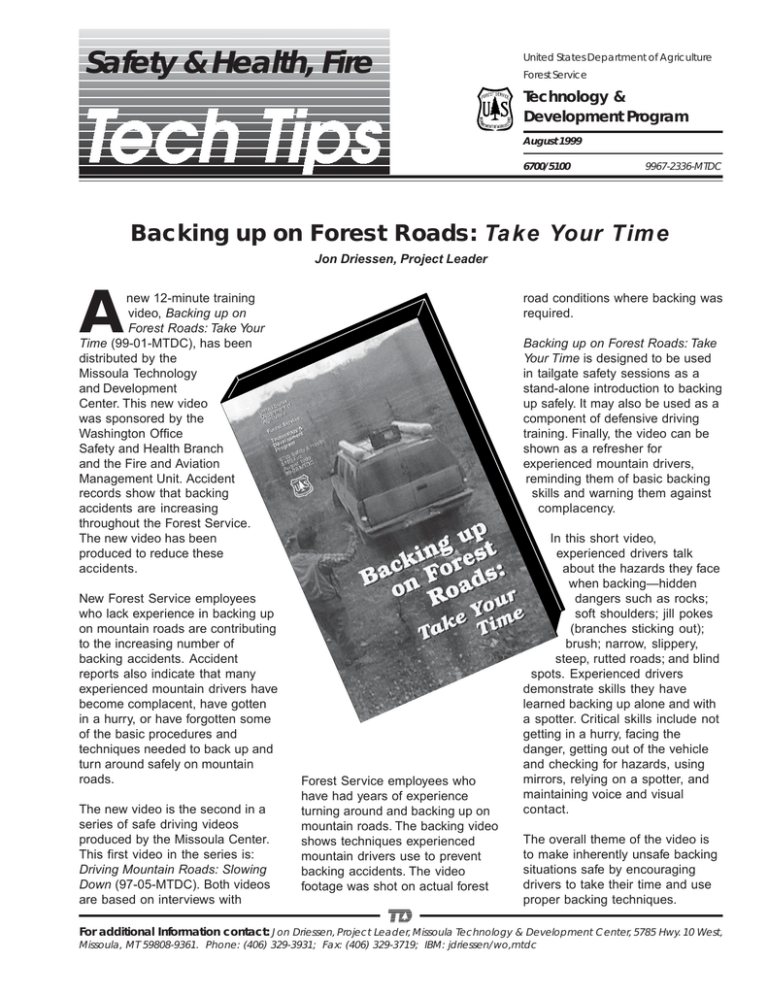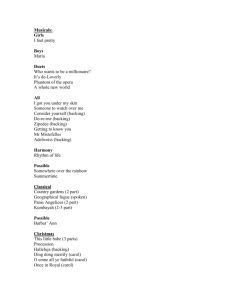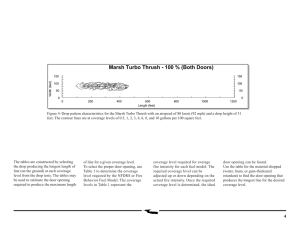
Safety & Health, Fire
United States Department of Agriculture
Forest Service
Technology &
Development Program
August 1999
6700/5100
9967-2336-MTDC
Backing up on Forest Roads: Take Your Time
Jon Driessen, Project Leader
A
new 12-minute training
video, Backing up on
Forest Roads: Take Your
Time (99-01-MTDC), has been
distributed by the
Missoula Technology
and Development
Center. This new video
was sponsored by the
Washington Office
Safety and Health Branch
and the Fire and Aviation
Management Unit. Accident
records show that backing
accidents are increasing
throughout the Forest Service.
The new video has been
produced to reduce these
accidents.
New Forest Service employees
who lack experience in backing up
on mountain roads are contributing
to the increasing number of
backing accidents. Accident
reports also indicate that many
experienced mountain drivers have
become complacent, have gotten
in a hurry, or have forgotten some
of the basic procedures and
techniques needed to back up and
turn around safely on mountain
roads.
The new video is the second in a
series of safe driving videos
produced by the Missoula Center.
This first video in the series is:
Driving Mountain Roads: Slowing
Down (97-05-MTDC). Both videos
are based on interviews with
road conditions where backing was
required.
Backing up on Forest Roads: Take
Your Time is designed to be used
in tailgate safety sessions as a
stand-alone introduction to backing
up safely. It may also be used as a
component of defensive driving
training. Finally, the video can be
shown as a refresher for
experienced mountain drivers,
reminding them of basic backing
skills and warning them against
complacency.
Forest Service employees who
have had years of experience
turning around and backing up on
mountain roads. The backing video
shows techniques experienced
mountain drivers use to prevent
backing accidents. The video
footage was shot on actual forest
In this short video,
experienced drivers talk
about the hazards they face
when backing—hidden
dangers such as rocks;
soft shoulders; jill pokes
(branches sticking out);
brush; narrow, slippery,
steep, rutted roads; and blind
spots. Experienced drivers
demonstrate skills they have
learned backing up alone and with
a spotter. Critical skills include not
getting in a hurry, facing the
danger, getting out of the vehicle
and checking for hazards, using
mirrors, relying on a spotter, and
maintaining voice and visual
contact.
The overall theme of the video is
to make inherently unsafe backing
situations safe by encouraging
drivers to take their time and use
proper backing techniques.
F
T
D
P
For additional Information contact: Jon Driessen, Project Leader, Missoula Technology & Development Center, 5785 Hwy. 10 West,
Missoula, MT 59808-9361. Phone: (406) 329-3931; Fax: (406) 329-3719; IBM: jdriessen/wo,mtdc
1
About the Author…
Jon Driessen received his Ph.D.
in sociology from the University of
Colorado in 1969. Since then he
has been a professor of sociology
at The University of Montana,
Missoula. Since 1977, he has
worked as a faculty affiliate at the
Missoula Technology and
Development Center.
Additional single copies of this
document may be ordered from:
USDA Forest Service
Missoula Technology and
Development Center
5785 Hwy. 10 West
Missoula, MT 59808-9361
Phone: (406) 329-3900
FAX: (406) 329-3719
IBM: pubs/wo,mtdc
E-mail: pubs/wo_mtdc@fs.fed.us
For further technical information,
please contact Gary Hoshide at
the address above.
Phone: (406) 329-1029
Fax: (406) 329-3719
IBM: ghoshide/wo,mtdc
E-mail: ghoshide/
wo_mtdc@fs.fed.us
An electronic copy of this document is available on the Forest
Service’s FSWeb Intranet at:
http://fsweb.mtdc.wo.fs.fed.us
F
T
D
P
The Forest Service, United States Department of Agriculture,
has developed this information for the guidance of its
employees, its contractors, and its cooperating Federal and
State agencies, and is not responsible for the interpretation
or use of this information by anyone except its own
employees. The use of trade, firm, or corporation names in
this publication is for the information and convenience of the
reader, and does not constitute an endorsement by the
2
Department of any product or service to the exclusion of
others that may be suitable. The United States Department of
Agriculture (USDA), prohibits discrimination in all its programs
and activities on the basis of race, color, national origin,
gender, religion, age, disability, political
beliefs, sexual
F
T
orientation, and marital or family status.
(Not all prohibited
D
P
bases apply to all programs.) Persons
with disabilities who
require alternative means for communication of program
information (Braille, large print, audiotape, and so forth)
should phone USDA’s TARGET Center at (202) 720-2600
(voice and TDD). To file a complaint of discrimination, write:
USDA, Director, Office of Civil Rights, Room 326-W, Whitten
Building, 14th and Independence Avenue SW, Washington, DC
20250-9410, or call (202) 720-5964 (voice or TDD). USDA is
an equal opportunity provider and employer.



